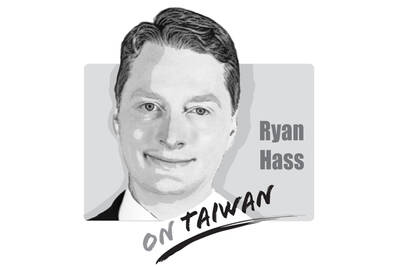Still recuperating from the destruction wrought by Typhoon Morakot in August, many in Taiwan can relate to the suffering of the people in the Philippines after Typhoon Ketsana struck over the weekend.
Typhoon Ketsana ravaged the northern Philippines on Saturday with torrential rainfall. Local weather reports said the rainfall was the heaviest the country had seen in four decades, dumping a month’s worth of monsoon rain in six hours on Saturday night and leaving 80 percent of metropolitan Manila submerged by the next morning. The country’s National Disaster Coordinating Council said yesterday that the typhoon has affected more than 2.2 million people and killed at least 246.
Within one day of Typhoon Ketsana wreaking havoc in the area, amid public accusations that the government was unprepared and mishandling the crisis, Philippine authorities were quick to apologize for delays in rescue efforts, citing difficulties in reaching flooded areas.
The Philippine government on Sunday appealed for international humanitarian aid, and President Gloria Arroyo frankly said Ketsana had “strained our response capabilities to the limit.”
On Monday, Arroyo opened the Malacanang Presidential Palace as an evacuation center to shelter flood victims. On Tuesday, she led her Cabinet members in donating two months’ salary to relief and reconstruction operations.
Although her critics panned her for not doing more — as the salaries she and her Cabinet members receive pale in comparison to their reportedly extensive personal assets — the gesture nonetheless served to suggest that government officials were contributing to overall relief work.
Facing similar destruction on the heels of Typhoon Morakot, not only did the administration of President Ma Ying-jeou (馬英九) fail to seek international aid, it flatly rejected assistance offered by some countries.
While Ma happily publicized his donation of NT$200,000 (US$6,240) in May last year for Sichuan Earthquake victims, this time the Presidential Office declined to reveal the amount Ma donated to southern Taiwan’s flood victims.
Furthermore, the Ma administration’s tardy apology for its slow rescue work came more than a week after hundreds perished, some of whom could probably have been saved with more prompt rescue efforts.
Beyond this less-than-flattering comparison comes the news that the Presidential Office has sought to expand the perimeter of the Boai District where the Presidential Office and the president’s official residence are located.
While the Presidential Office said the president’s security was the main reason behind the re-zoning, skeptics say the plan is actually a preemptive measure to keep future protesters further away from Ma.
“I feel the people’s pain,” Ma has repeatedly said. “The people’s pain is my pain, and your suffering is my suffering.”
It is clear that Ma has a lot to do to show Taiwanese that he cares as much as he says he does. By seeking to keep protesters at an increased distance, the president has further demonstrated that he is not interested in hearing the public’s dissatisfaction, let alone “feeling their pain.”
The diplomatic dispute between China and Japan over Japanese Prime Minister Sanae Takaichi’s comments in the Japanese Diet continues to escalate. In a letter to UN Secretary-General Antonio Guterres, China’s UN Ambassador Fu Cong (傅聰) wrote that, “if Japan dares to attempt an armed intervention in the cross-Strait situation, it would be an act of aggression.” There was no indication that Fu was aware of the irony implicit in the complaint. Until this point, Beijing had limited its remonstrations to diplomatic summonses and weaponization of economic levers, such as banning Japanese seafood imports, discouraging Chinese from traveling to Japan or issuing

There has been much catastrophizing in Taiwan recently about America becoming more unreliable as a bulwark against Chinese pressure. Some of this has been sparked by debates in Washington about whether the United States should defend Taiwan in event of conflict. There also were understandable anxieties about whether President Trump would sacrifice Taiwan’s interests for a trade deal when he sat down with President Xi (習近平) in late October. On top of that, Taiwan’s opposition political leaders have sought to score political points by attacking the Lai (賴清德) administration for mishandling relations with the United States. Part of this budding anxiety
The diplomatic spat between China and Japan over comments Japanese Prime Minister Sanae Takaichi made on Nov. 7 continues to worsen. Beijing is angry about Takaichi’s remarks that military force used against Taiwan by the Chinese People’s Liberation Army (PLA) could constitute a “survival-threatening situation” necessitating the involvement of the Japanese Self-Defense Forces. Rather than trying to reduce tensions, Beijing is looking to leverage the situation to its advantage in action and rhetoric. On Saturday last week, four armed China Coast Guard vessels sailed around the Japanese-controlled Diaoyutai Islands (釣魚台), known to Japan as the Senkakus. On Friday, in what
On Nov. 8, newly elected Chinese Nationalist Party (KMT) Chairwoman Cheng Li-wun (鄭麗文) and Vice Chairman Chi Lin-len (季麟連) attended a memorial for White Terror era victims, during which convicted Chinese Communist Party (CCP) spies such as Wu Shi (吳石) were also honored. Cheng’s participation in the ceremony, which she said was part of her efforts to promote cross-strait reconciliation, has trapped herself and her party into the KMT’s dark past, and risks putting the party back on its old disastrous road. Wu, a lieutenant general who was the Ministry of National Defense’s deputy chief of the general staff, was recruited